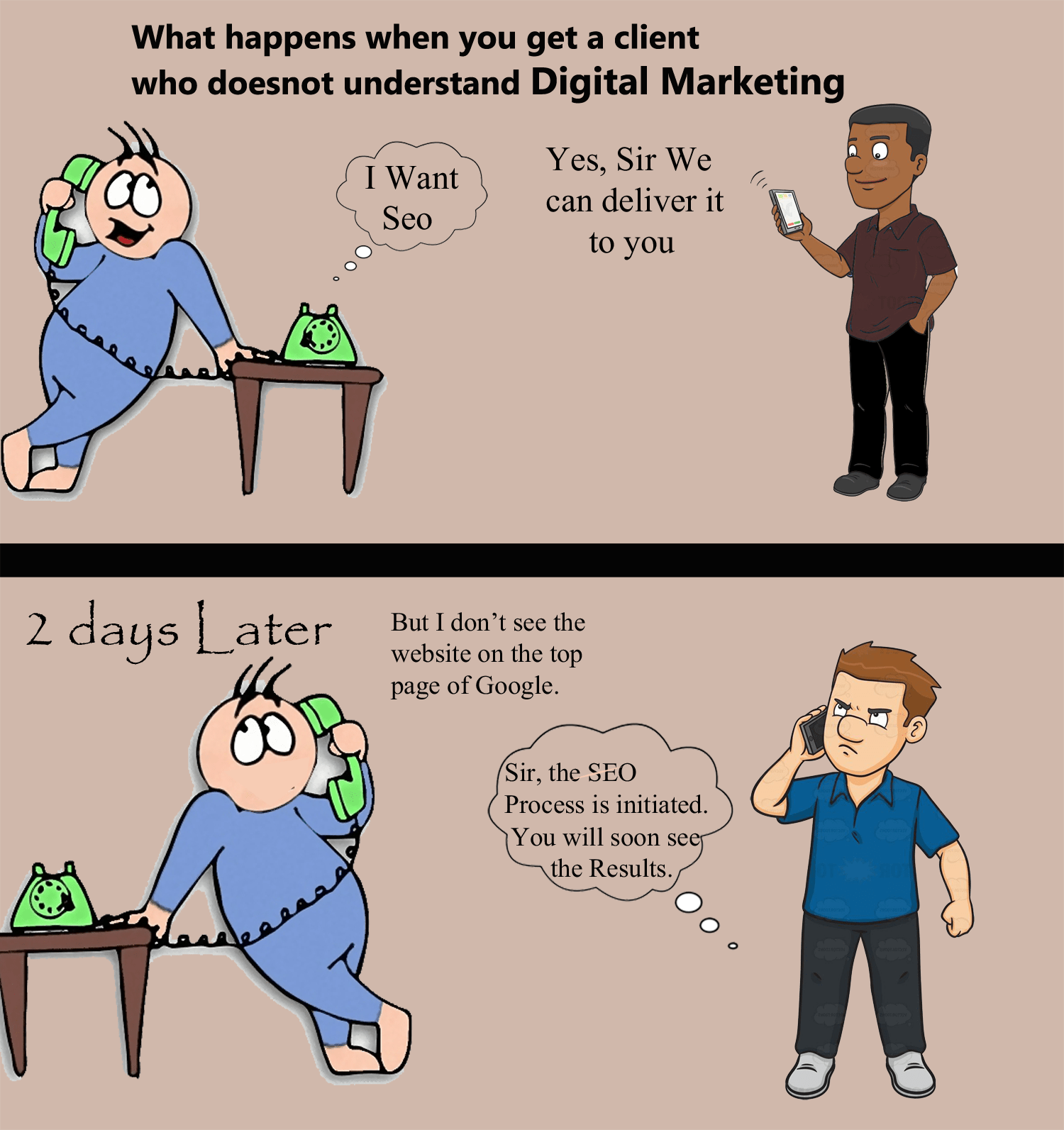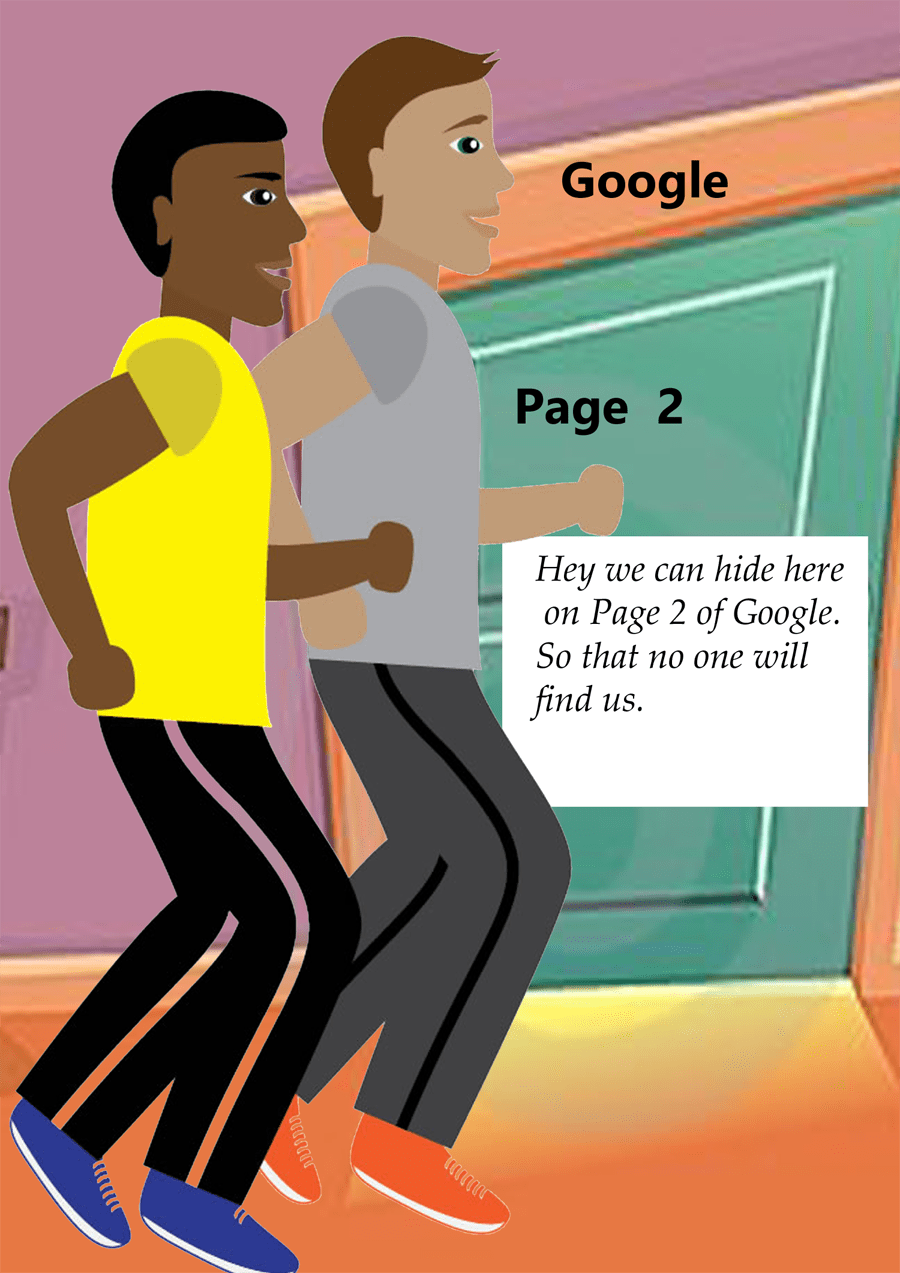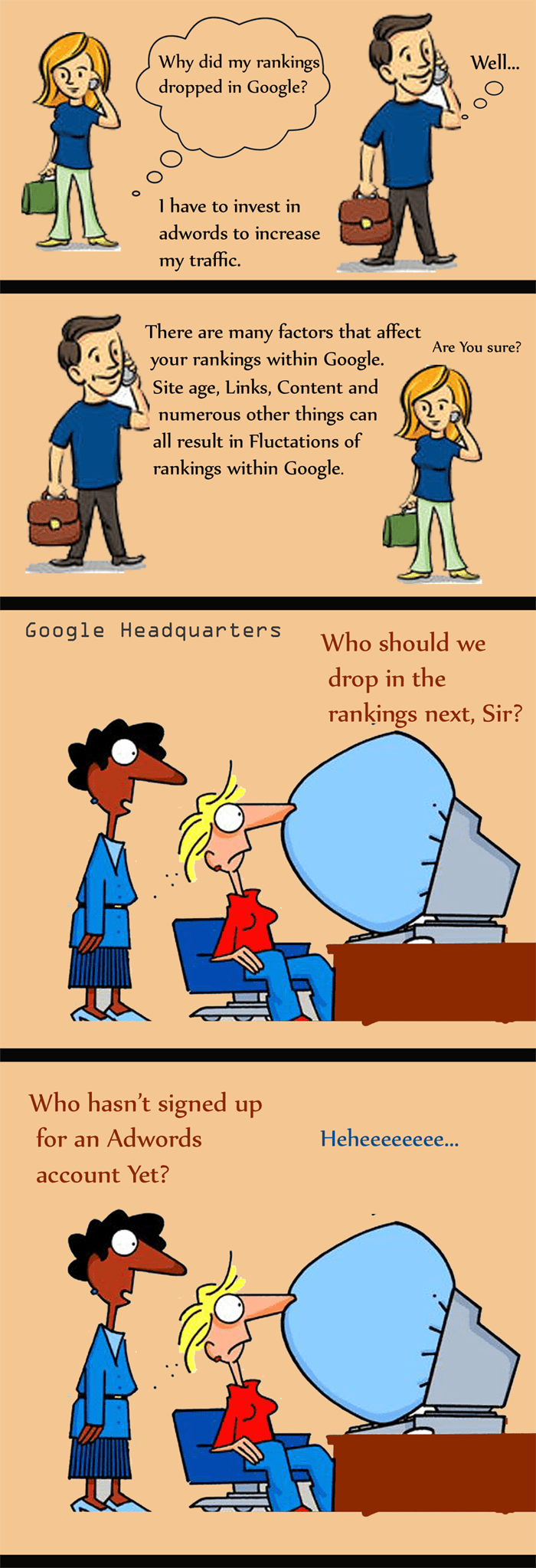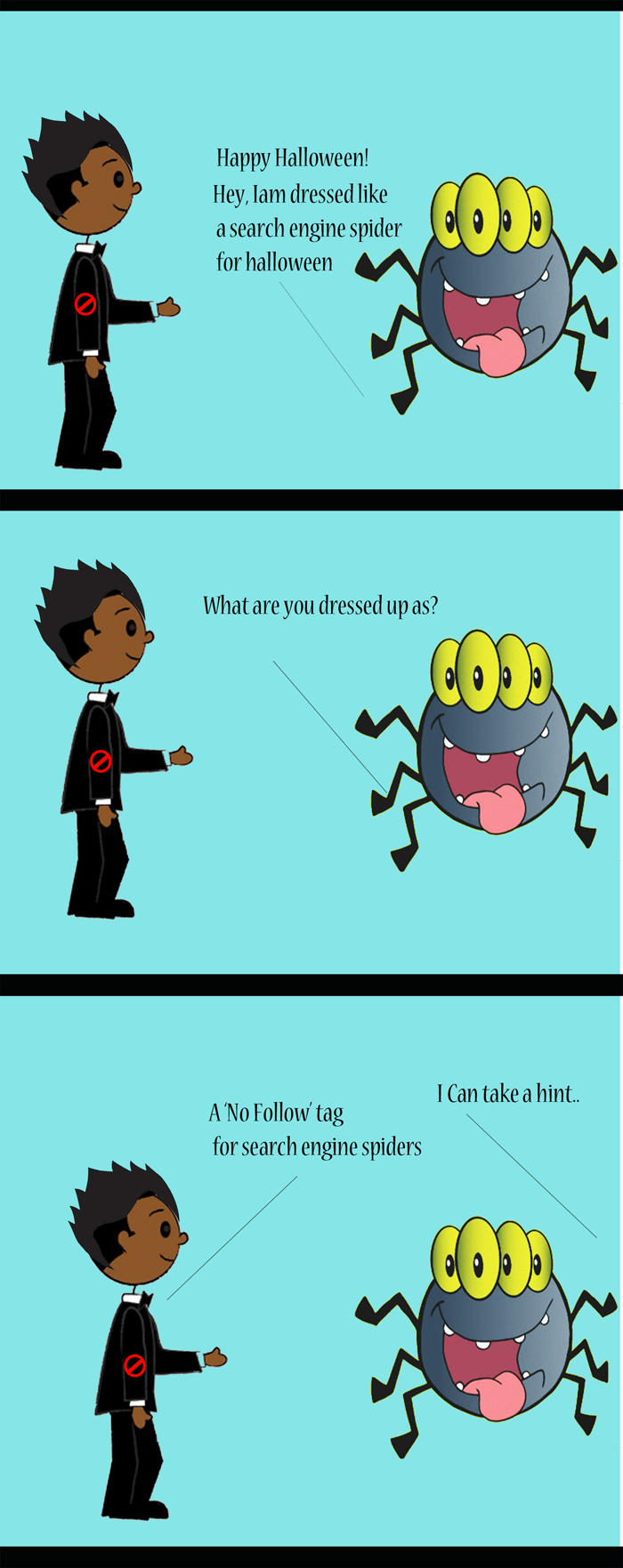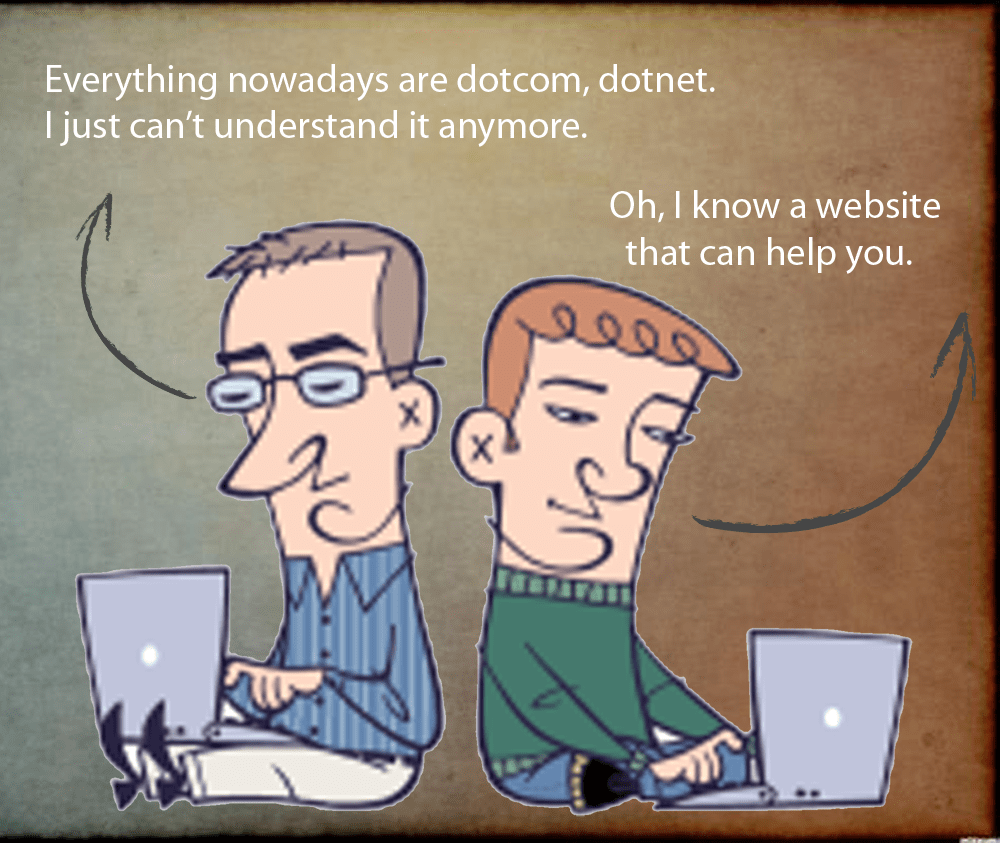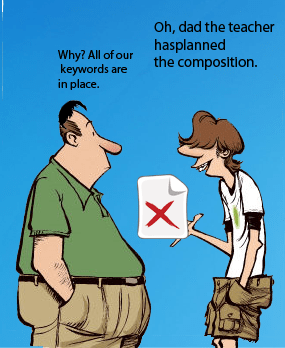website
SEO Funny Cartoon Comics -latest trends of 2016
Search Engine Optimization (SEO) is arguably the most cost-effective digital marketing technique, but also the most challenging to get right.
The First very Organic Result on the First Search Engine Result Page sees about 32.5%of Overall Search Traffic in terms of clicks. The Second domain sees 17.6% while the 7th only sees 3.5%
Google PageRank (Google PR) is one of the methods Google uses to determine a page’s relevance or importance. Important pages receive a higher PageRank and are more likely to appear at the top of the search results. Google PageRank (PR) is a measure from 0 – 10. Google Page rank is based on back links
Web Search Engines and some other sites use Web crawling or spidering software to update their Web Content or indices of others sites’ web content. Web crawlers can copy all the pages they visit for later processing by a search engine which indexes the downloaded pages so the users can search much more efficiently.
A website is a collection of related webpages, including multimedia content, typically identified with a common domain name and published on at least one webserver.
A keyword, in the context of search engine optimization, is a particular word or phrase that describes the contents of a Web page.
Google is used for search of information about (someone or something) on the Internet using the search engine Google.
SEO Blog Back Again
I have to personally take the blame for not updating my blog regularly. I am learning to get rid of this laziness in me. Ill make sure from now on ill keep you entertained with my posts. Also blogger ftp being discontinued affected our blogs but that was not till end if May. I don’t have an explanation for not posting before may. My last posting was in Feb, that is 4 months before blogger discontinued allowing FTP publishing. Now I am back to some serious blogging I will be giving you latest updates in SEO industry and also will continue to share my experiences that I have gained over the years.
What determines a website size?
Particularly in SEO industry we are used to calling small, medium sized, large and extra large websites. So what determines the size. Well size is a relative word in our industry. It’s important we know the size before quoting for SEO work or starting work on the site.
Small sized sites: Most of the small Business sites that come to us a small. People think just putting one website online is enough to be on top of search engines. Fact its not enough we need to have a quality site to be on top. We say a site is small when it is built completely in flash, or html sites with only 10 to 20 pages ( without any database / products ) , just pages with contact and few other pages, sites that have products but very few like 10 or 20 etc. If sites like these come to us we tell our clients to add blogs, articles, news and all other possible information that helps SEO and helps expand the size of the site.
Medium sized website: Medium sized website sites that has decent amount of pages with articles, good well written information pages, at-least 50 products etc. Medium sized websites are ideal for targeting regional and low competitive keywords. So we prefer to take medium sized sites for SEO for low competitive keywords. To be eligible to be medium sized you can say the site should have at least search engine crawl able pages. We don’t consider flash sites as medium sized even if it has 500 pages embedded into flash. It’s because flash are still not efficiently crawled and it’s difficult for us to optimize a flash website.
Large websites: Large websites are mostly product based websites. We get lots of websites that are product driven for optimization. Some sites have up to 10,000 products. It can range from costumes, cosmetics, tools etc. In rare cases we get large websites that are not product based but still have 1000s of pages. These websites have good contents already and it’s easier to optimize. A large website is mostly database driven and it’s eligible to be called large only if it has 1000s of search engine index-able pages.
Very large websites: These websites are rare but lots of them exist we rarely take these sites for SEO because it contains more than 100,000 products and it’s not easy to optimize these sites. We had a client in medicine industry that had more than 150,000 pages. Optimization was never easy because it’s difficult to funnel PageRank and backlink power to all those pages.
So as you can see from my explanation size is a more relative word. Online marketing industry is the most concerned when it comes to size. We take size seriously. www replica watch shop com tag heuer replica replica watches for men omega replica breitling copy
Website not getting crawled due to potential history of penalty:
We have this question asked by few of our website visitors, does a site stop getting crawled if Googlebot detects any previous penalty or ban on that website. I would say yes we have seen this being reported by some of our potential clients or by people in forums. I assume Google has a list of all sites that was previously blacklisted in Google rankings. When Googlebot detects a link to a website that was previously blacklisted then it will first take that link and will store in a database. Later Google’s algorithm will decide whether that link is crawl worthy and then Google crawler will be sent to crawl and index that website.
Best way to see if your site has any historical spam flag is to check in archive.org. Archive way back machine will have your old pages indexed if it ever existed. If you are sure what is the problem with your website then explain that carefully in a re-inclusion request and I am sure Google will accept your website.
Penalties apply to Google too:
2 months back Google.co.jp , Google’s japan domain was penalized for buying pay per post promotional links from leading Pay per post agency cyberbuzz.com . A visible example of Google Japan’s penalty can been seen if you have Pagerank enabled in Google toolbar. Google Japan has a pagerank of 5 now compared to pagerank 9 it previously had.
An extract from their promotional campaign:
“The Google Hot Keywords blog widget [link to Google’s page] can show you what is in fashion now, and what other people are interested in.
It’s appealing that you can view buzzwords from the previous day or the previous week. I am sometimes surprised to see that such words are so popular! Personally, I like the “fortune-teller” feature from the previous week’s ranking. When I click on a keyword, I am quickly taken to Google’s result page and so I enjoy the feature.
I might not have noticed them by myself, but now I understand that these things are what people care about.
I am participating in CyberBuzz’s campaign.
“
After realizing their problem and other bloggers reporting the problem with them, here is the apology from their official blog:
“”Google Japan is running several promotional activities to let people know more about our products.
It turns out that using blogs on the part of the promotional activities violates Google’s search guidelines, so we have ended the promotion. We would like to apologize to the people concerned and to our users, and are making an effort to make our communications more transparent in order to prevent the recurrence of such an incident.”
Websites targets ignorant offering grants money:
Some scam websites that advertise with Google or rank in Google organic results are scamming people about Obama Stimulus package. According to those websites you can buy a home, a car, pay credit card bills, invest in Business, run a business or can do anything with that money. To find these scam sites just type “government grants” , “grants” , stimulus share , stimulus package , stimulus etc.
Con artists are creating and running scam websites like federalgovernmentgrantsolutions.com, OfficialStimulusPayments.com etc and lure ignorant people for spending to some crap services. Scammers create bogus blogs too and redirect traffic to sites that offer tips on bogus grant offers.
“A company in Las Vegas called The Grant Instructor has generated even more complaints – 450 so far. The BBB says the company, which also has an “F” grade, runs at least two dozen sites with names such as: American Grant Club, Get My Grant, Grant Dollars, Grants Are Easy, Grant Resource Center and Your American Grant.
Christopher Gaffer of Mankato, Minn. stumbled onto one of their sites called “The Grant Search.” Gaffer is on the board of a non-profit group in Mankato that helps provide affordable housing. Part of their funding comes from grants. Gaffer went online to look for new funding opportunities.
The initial cost was just $1.95 for seven days access to the Grant Search database. Gaffer paid but never got his access code. Seven days later, he found a charge for $49.50 on his credit card for “a recurring monthly membership.” Gaffer tried to contact the company but could not find a phone number or e-mail address. “It was a nightmare,” he says.
http://www.msnbc.msn.com/id/29643680/
Vulnerable sites Alert letter from Google now shown in Google webmaster tools
Google now shows security hole / vulnerable site warning mails in webmaster blog itself.
According to webmaster blog:
Recently we’ve seen more websites get hacked because of various security holes. In order to help webmasters with this issue, we plan to run a test that will alert some webmasters if their content management system (CMS) or publishing platform looks like it might have a security hole or be hackable. This is a test, so we’re starting out by alerting five to six thousand webmasters. We will be leaving messages for owners of potentially vulnerable sites in the Google Message Center that we provide as a free service as part of Webmaster Tools. If you manage a website but haven’t signed up for Webmaster Tools, don’t worry. The messages will be saved and if you sign up later on, you’ll still be able to access any messages that Google has left for your site.
One of the most popular pieces of software on the web is WordPress, so we’re starting our test with a specific version (2.1.1) that is known to be vulnerable to exploits. If the test goes well, we may expand these messages to include other types of software on the web. The message that a webmaster will see in their Message Center if they run WordPress 2.1.1 will look like this:
Quick note from Matt: In general, it’s a good idea to make sure that your webserver’s software is up-to-date. For example, the current version of WordPress is 2.6.2; not only is that version more secure than previous versions, but it will also alert you when a new version of WordPress is available for downloading. If you run an older version of WordPress, I highly encourage you to upgrade to the latest version.
Top 10 Global brands – rated 2008 rankings for top brands globally.
1. Coca-Cola – The Coca-Cola Company (NYSE: KO) is the world’s largest beverage company, largest manufacturer, distributor and marketer of non-alcoholic beverage concentrates and syrups in the world, and one of the largest corporations in the United States. The company is best known for its flagship product Coca-Cola, invented by pharmacist John Stith Pemberton in 1886. The Coca-Cola formula and brand was bought in 1889 by Asa Candler who incorporated The Coca-Cola Company in 1892. Besides its namesake Coca-Cola beverage, Coca-Cola currently offers nearly 400 brands in over 200 countries or territories and serves 1.5 billion servings each day.[2]
The company operates a franchised distribution system dating back to 1889 where The Coca-Cola Company only produces syrup concentrate which is then sold to various bottlers throughout the world who hold an exclusive territory.
The Coca-Cola Company is headquartered in Atlanta, Georgia. Its stock is listed on the NYSE and is part of DJIA and S&P 500. Its current president and CEO is Muhtar Kent.
2. IBM – The character of a company — the stamp it puts on its products, services and the marketplace — is shaped and defined over time. It evolves. It deepens. It is expressed in an ever-changing corporate culture, in transformational strategies, and in new and compelling offerings for customers. IBM’s character has been formed over nearly 100 years of doing business in the field of information-handling. Nearly all of the company’s products were designed and developed to record, process, communicate, store and retrieve information — from its first scales, tabulators and clocks to today’s powerful computers and vast global networks.
IBM helped pioneer information technology over the years, and it stands today at the forefront of a worldwide industry that is revolutionizing the way in which enterprises, organizations and people operate and thrive.
The pace of change in that industry, of course, is accelerating, and its scope and impact are widening. In these pages, you can trace that change from the earliest antecedents of IBM, to the most recent developments. You can scan the entire IBM continuum from the 19th century to the 21st or pinpoint — year-by year or decade-by-decade — the key events that have led to the IBM of today. We hope that you enjoy this unique look back at the highly textured history of the International Business Machines Corporation.
3. Microsoft – Microsoft Corporation is an American multinational computer technology corporation, which rose to dominate the home computer operating system market with MS-DOS in the mid-1980s, followed by the Windows line of operating systems.
Throughout its history the company has been the target of criticism for various reasons, including monopoly status and anti-competitive business practices including refusal to deal and tying. The U.S. Justice Department and the European Commission, among others, have ruled against Microsoft for various antitrust violations.[8][9]
It develops, manufactures, licenses, and supports a wide range of software products for computing devices.[10][7] Microsoft’s best-selling products are the Microsoft Windows operating system and the Microsoft Office suite of productivity software.
4. GE – The General Electric Company, or GE (NYSE: GE) is a multinational American technology and services conglomerate incorporated in the State of New York.[5] In terms of market capitalization as of 30th June 2008, GE is the world’s sixth largest company and also second in the BrandZ ranking. In the 1960s, aspects of U.S. tax laws and accounting practices led to a rise in the assembly of conglomerates. GE, which was a conglomerate long before the term was coined, is arguably the most successful organization of this type.
5. Nokia – Nokia is a Finnish multinational communications corporation, headquartered in Keilaniemi, Espoo, a city neighbouring Finland’s capital Helsinki. Nokia is focused on wireless and wired telecommunications, with 112,262 employees in 120 countries, sales in more than 150 countries and global annual revenue of 51.1 billion euros and operating profit of 8.0 billion as of 2007.[1][3] It is the world’s largest manufacturer of mobile telephones: its global device market share was about 40% in Q2 of 2008, up from 38% in Q2 2007 and up from 39% sequentially.[2] Nokia produces mobile phones for every major market segment and protocol, including GSM, CDMA, and W-CDMA (UMTS). Nokia’s subsidiary Nokia Siemens Networks produces telecommunications network equipments, solutions and services.
6. Toyota – Toyota Motor Corporation (トヨタ自動車株式会社, Toyota Jidosha Kabushiki-gaisha?) (pronounced [to-yo-ta]) is a multinational corporation headquartered in Japan, and is currently the world’s largest automaker.[3][4]
In 1934, while still a department of Toyota Industries, it created its first product Type A engine and in 1936 its first passenger car the Toyota AA. The company was eventually founded by Kiichiro Toyoda in 1937 as a spinoff from his father’s company Toyota Industries to create automobiles. Toyota currently owns and operates Lexus and Scion brands and has a majority shareholding stake in Daihatsu Motors,[5] and minority shareholdings in Fuji Heavy Industries Isuzu Motors, and Yamaha Motors. The company includes 522 subsidiaries.[6]
Toyota is headquartered in Aichi, Nagoya and in Tokyo. In addition to manufacturing automobiles, Toyota provides financial services through its division Toyota Financial Services and also creates robots. Toyota Industries and Finance divisions form the bulk of the Toyota Group, one of the largest conglomerates in the world
7. Intel – Intel Corporation (NASDAQ: INTC; SEHK: 4335) is the world’s second largest semiconductor company and the inventor of the x86 series of microprocessors, the processors found in most personal computers. Founded on July 18, 1968 as Integrated Electronics Corporation and based in Santa Clara, California, USA, Intel also makes motherboard chipsets, network cards and ICs, flash memory, graphic chips, embedded processors, and other devices related to communications and computing. Founded by semiconductor pioneers Robert Noyce and Gordon Moore, and widely associated with the executive leadership and vision of Andrew Grove, Intel combines advanced chip design capability with a leading-edge manufacturing capability. Originally known primarily to engineers and technologists, Intel’s successful “Intel Inside” advertising campaign of the 1990s made it and its Pentium processor household names.
Intel was an early developer of SRAM and DRAM memory chips, and this represented the majority of its business until the early 1980s. While Intel created the first commercial microprocessor chip in 1971, it was not until the success of the personal computer (PC) that this became their primary business. During the 1990s, Intel invested heavily in new microprocessor designs and in fostering the rapid growth of the PC industry. During this period Intel became the dominant supplier of microprocessors for PCs, and was known for aggressive and sometimes controversial tactics in defense of its market position, as well as a struggle with Microsoft for control over the direction of the PC industry.[5][6] The 2007 rankings of the world’s 100 most powerful brands published by Millward Brown Optimor showed the company’s brand value falling 10 places – from number 15 to number 25.[7]
8. McDonald’s – McDonald’s Corporation (NYSE: MCD) is the world’s largest chain of fast food restaurants, serving nearly 47 million customers daily.[3] McDonald’s primarily sells hamburgers, cheeseburgers, chicken products, French fries, breakfast items, soft drinks, milkshakes and desserts. More recently, it has begun to offer salads, wraps and fruit. Many McDonald’s restaurants have included a playground for children and advertising geared toward children, and some have been redesigned in a more ‘natural’ style, with a particular emphasis on comfort: introducing lounge areas and fireplaces, and eliminating hard plastic chairs and tables.
In addition to its signature restaurant chain, McDonald’s Corporation holds minority interest in Pret A Manger (a UK-based sandwich retailer), and owned the Chipotle Mexican Grill until 2006 and the restaurant chain Boston Market until 2007.[4] The company has also expanded the McDonald’s menu in recent decades to include alternative meal options, such as salads and snack wraps, in order to capitalize on growing consumer interest in health and wellness.
Each McDonald’s restaurant is operated by a franchisee, an affiliate, or the corporation itself. The corporations’ revenues come from the rent, royalties and fees paid by the franchisees, as well as sales in company-operated restaurants. McDonald’s revenues grew 27% over the three years ending in 2007 to $22.8 billion, and 9% growth in operating income to $3.9 billion.[5]
9. Disney – The Walt Disney Company (NYSE: DIS) is one of the largest media and entertainment corporations in the world. Founded on October 16, 1923, by brothers Walt and Roy Disney as an animation studio, it has become one of the biggest Hollywood studios, and owner of eleven theme parks and several television networks, including ABC and ESPN. Disney’s corporate headquarters and primary production facilities are located at The Walt Disney Studios in Burbank, California. The company is a component of the Dow Jones Industrial Average.
10. Google – Google Inc. is an American public corporation, earning revenue from advertising related to its Internet search, e-mail, online mapping, office productivity, social networking, and video sharing services as well as selling advertising-free versions of the same technologies. The Google headquarters, the Googleplex, is located in Mountain View, California. As of 30 June 2008 the company has 19,604 full-time employees.[
Is Google.com dropping country specific TLDs .
A webmaster world member has reported seeing Google drop country specific TLDs like transport.co.uk or mobilephones.co.in from their .com search.
He says
“I have noticed that Google.com isn’t showing .co.uk websites in it’s results as often as it used to, in fact .co.uk sites that I have always seen high up in the results seem to have disappeared completely from Google.com results whilst still featuring well in the Google.co.uk results.
Is Google systematically dropping .co.uk domains from it’s main SERPs seeing as Google.co.uk has taken off so well since it’s introduction?
I don’t think I have heard of this happening anywhere else on the web.. so thought I’d mention it 🙂 “
Well i haven’t see this happen atleast from where i see the results. if you notice it please comment in my blog
Google introduces webmaster tools access provider program
Webmaster tools Access provider pilot program,
Google has recently come up with a new option in webmaster tools where they enable hosting companies to integrate webmaster tools features into their hosting plans as well their servers. Google has recently read this new technology and it works great.
With the help of Google APIs webmaster tools can be directly integrated in web hosting control panel. For products like Cpanel its very easy to get something like running using webmaster tools hosting programm, Also hosting companies which uses Google webmaster tools will receive a badge which says Google webmaster access provider which will help web hosting providers an other reason to promote their business.
“
Google Webmaster Tools helps your customers understand site traffic and diagnose potential problems by providing insight into how Google crawls and indexes their site.

With the Google APIs, you can integrate Google Webmaster Tools into your customer’s control panel, so customers can create accounts and submit Sitemaps without leaving your service.

Sergey plans his space invasion
Blogroll
Categories
- 2013 seo trends
- author rank
- Bing search engine
- blogger
- Fake popularity
- google ads
- Google Adsense
- google fault
- google impact
- google Investigation
- google knowledge
- Google panda
- Google penguin
- Google Plus
- Google webmaster tools
- Hummingbird algorithm
- infographics
- link building
- Mattcutts Video Transcript
- Microsoft
- MSN Live Search
- Negative SEO
- pagerank
- Paid links
- Panda and penguin timeline
- Panda Update
- Panda Update #22
- Panda Update 25
- Panda update releases 2012
- Penguin Update
- Sandbox Tool
- search engines
- SEO
- SEO cartoons comics
- seo predictions
- seo techniques
- SEO tools
- seo updates
- social bookmarking
- Social Media
- SOPA Act
- Spam
- Uncategorized
- Webmaster News
- website
- Yahoo





